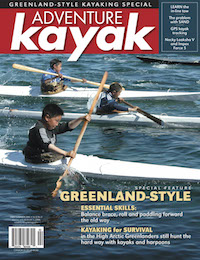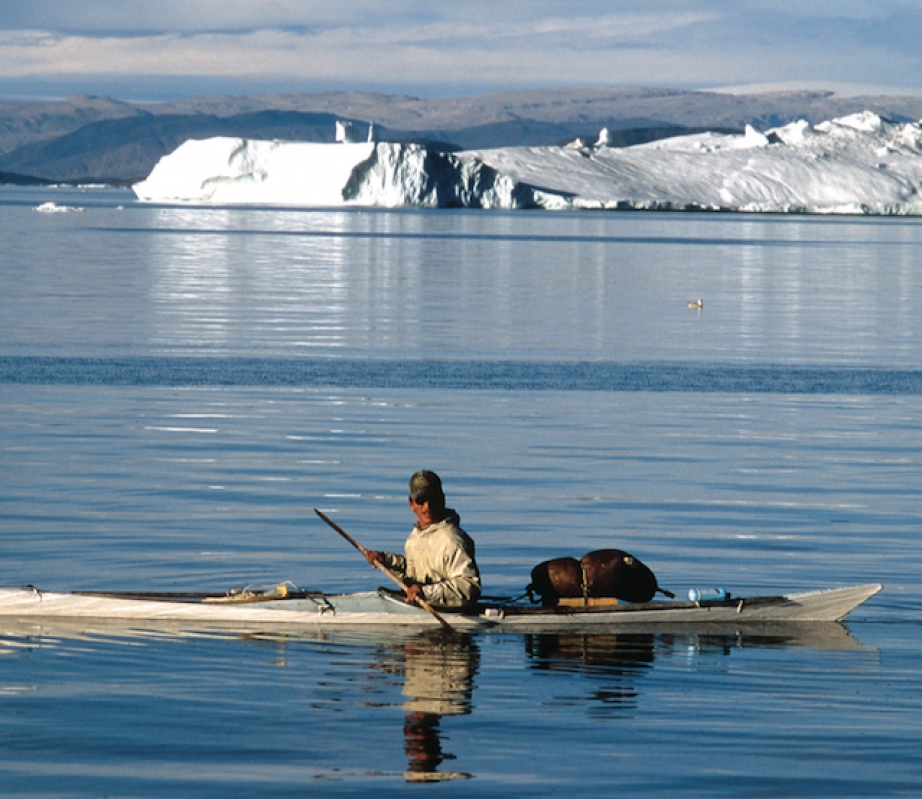For the people of northwest Greenland, culture and nature are deeply linked. A rule that requires hunting to be done from kayaks is helping to preserve both.
The Inuk’s patience and focus are awesome. Pauloos Simigaq has been floating on the mercurial, iceberg-choked waters of Inglefield Fjord for hours with only the unbroken water and the occasional Marlboro to pass the cramped time in his homemade, canvas-covered kayak.
He is nestled against one of the countless bits of fractured ice pan in the fjord—the white underbelly of his kayak blending in with the ice when viewed from below. The boat, his paddle and harpoon, his seat made of a skinned polar bear head, and his sealskin boots all resemble those his father wore, and those worn by countless preceding generations of Inughuit hunters.
Without warning the silence is split by a wet, hollow “pfew…pfew” of exhaled breath and the still surface of the fjord is broken by the watermelon-like heads of a small pod of narwhal. Their wake leaves a jagged arrow on the silver sky-reflection of the sea, as they rise from their deep-water halibut feasting to fill their black blood with oxygen.
Pauloos, alert, hurriedly pinches off the embers of his cigarette with his calloused fingers and slips the butt into the front pocket of his white cotton anorak. His wife, Inge, has been watching with our group of southern tourists on the lookout—a grassy prow of land that affords a 180-degree view of the fjord, and warns Pauloos of the approach of the narwhal with a tiny handheld radio. Such is the paradoxical situation of the Greenland Inuit—with one weathered hand Pauloos stows his thin-bladed hand-carved paddle and adjusts his ivory-tipped harpoon, and with the other he holds the portable radio to his mouth, asking Inge where the narwhal are in relation to him, which way they are heading.
Soon he sees the rounded heads moving through the ice floes toward him. Slicing the water ahead of the pod are the sharp points of the males’ spiral horns—the unique teeth from which sprang the legend of the unicorn when the first narwhal tusks appeared in mainland Europe in the Middle Ages. These mysterious horns were said to have magical cure-all properties and were bought and sold for small fortunes.
Pauloos pulls away from his iceberg port and sprints after the pod. From a comfortable perch amid the poppies, avens, grasses and blueberries that give this icy land its name, we watch with the same held breath that permeates the entire fjord.
Pauloos’ thin-bladed paddle allows him to fly silently toward the rearguard of the narwhal pod. As he closes in, with one swift motion he stows his paddle, hefts his harpoon and draws his arm back for the throw.
Our group of foreign ecotourists has ostensibly travelled here to observe the wonder of Arctic wildlife, not to watch wildlife be killed. But the long-forgotten hunter in us somehow wills the harpoon point toward flesh—a hope that we can no more make sense of than we can fight.
Pauloos Simigaq is a hunter in a way few modern people would comprehend. He is not out here to bond with his buddies or to prove his prowess. He is not even out here with the typical southern excuse that he needs to “get away from the wife”—inge simigaq and their three young children, Mikael, Nialianguaq, and Utuuniaq, are along for the hunt as well. Pauloos and his family are out here hunting because they know no other life, and because it is truly their identity. They are inughuit—a word that means “the real people.” Pauloos simply is a hunter. Period.
Even his home, Qaanaaq (dubbed “the world’s most northerly palindrome” by the Lonely Planet guidebook), is a modern version of a traditional camp. it boasts 860 Danish and inughuit inhabit- ants, and an estimated 3,000 sled dogs; days in qaanaaq are eight parts arctic quiet and two parts howling cacophony.
The traditional hunting in this part of the High Arctic has earned the inughuit a reputation as some of the few remaining true hunters on the planet. Food gathering here is as much ritual as it is necessity, and even the methods are echoes from what would be termed a “long forgotten” past in any other part of the world.
Here, little is forgotten.
Most narwhals in Greenland and the Canadian Arctic are hunted with high-powered rifles fired from modern boats with outboard motors—a tough sell as a “traditional hunt.” little is known of even the basic life history of the narwhal, including its reproductive rate and natural mortality rate, and this has raised concerns about the sustainability of these modern hunts which often fail to retrieve as many as 50 per cent of the animals that are wounded or killed by the hunters’ bullets.
Only in the Thule District of northwest Greenland are narwhals hunted from traditional kayaks using harpoons and sealskin float bags. These are the rules here—motor boats can be used to transport a family or hunting party to the hunting grounds and to bring the meat and muktuq back to the village, but the actual hunt and capture of the animal must be done from a traditional kayak.
This true traditional hunt fulfills two purposes. First, it anchors the people’s ties to their cultural past with an unforgiving certainty, requiring a commitment unheard of in most modern cultures. Without these Thule hunting laws, the ancient kayak techniques and the inughuit culture would have been lost or forever changed years ago, as it has been in much of the modern Arctic.
There is also a perception, communicated with laughter and curious inspection of our bright red rotomoulded plastic kayaks, that the traditional technology is far superior to the modern.
The canvas-covered boats are lighter by far than our tandems, and are relatively easy to build and re- pair with the materials at hand; the time-tested hull design allows for a critical mix of speed and stability ideally suited to hunting large marine mammals.
The second purpose of the traditional hunt is that it both limits the number of narwhal killed and the number that are mortally wounded and lost. Not many hunters are dedicated enough to spend weeks building their own kayak, harpoons, and paddle, and then spend cramped, dangerous hours float- ing amongst the icebergs of Inglefield Fjord waiting for their narwhal. The fact that every year at least one hunter either has a very close call or simply vanishes into the icy seas adds a further deterrent.
Those who are patient and brave enough to hunt, however, are almost guaranteed to bring home the muktuq from any narwhal they successfully harpoon and kill, barring the unpredictable intervention of arctic ice and weather. Attached to the hunter’s harpoon tether is an inflated sealskin bag, like a giant bagpipe bag with claws. A successful harpoon strike anchors the harpoon head to the narwhal. The float tires the animal out to hasten the kill and keeps the animal afloat once it is killed, ensuring that most har- pooned animals are retrieved.
In a way this is true conservation, not only of human experience and culture, but of wildlife as well—an answer to sustainable harvest of our large marine mam- mals that was discerned centuries ago by the forebears of Pauloos and the Inughuit—a people wise enough to recognize and live by the concept of “enough.”
As I watch Pauloos’ spear sail over the water, the biologist in me wonders for the future of the mythical narwhal—a creature that is listed as “of special concern” in Canada and whose numbers have been dwindling throughout the animals’ range. But the romantic in me senses the pure resonance of the his- tory, courage and power of what we are witnessing, and I inwardly cheer when the arc of Pauloos’ throw climaxes with a bloody spray and frenzied splashing as the entire herd senses the danger and dives for the shelter of the frigid water.
This is the most dangerous time for the hunter, as with one hand he sculls his paddle to balance in the wake and mad splash of several tonnes of terrified whale flesh, and with the other he rapidly and deftly pays out the cord attached to the harpoon buried deep in the narwhal’s side.
Finally Pauloos pulls the sealskin float safely from the stern deck of his kayak and watches it speed away across the fjord to disappear with a sudden “plop” into the black depths, leaving only ripples to recall the drama of the moment.
The held breath of everyone watching seems to re- lease as Pauloos calmly paddles over to retrieve his harpoon shaft where it now floats. he stows the re- trieved shaft and his paddle, calmly lights a cigarette, and watches for his sealskin float to return its prize to the still surface of Inglefield Fjord.
Dave Quinn is a freelance writer, photographer and guide based in Kimberley, BC. He has visited the Thule District of Greenland three times in the past two years.




